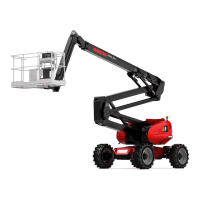0 2 4 6 8 10 12
2
4
6
8
10
12
14
16
18
20
0 2 4 6 8 10 12
230 kg
510 lbs
=
=
+
+
70 kg
155 lbs
2
5
A
B
27
t
IMPORTANT
t
Operators should be aware of the risks connected with using the lift platform, notably:
- Risk of losing control.
- Risk of losing lateral stability of the lift platform.
- A safety helmet and a harness MUST be worn when using the platform.
PLATFORM WORKING AREA
SLOPE AND OVERLOAD
TURNTABLE ROTATION BLOCK
EMERGENCY PROCEDURE
ELECTRICAL HAZARD
BACKUP PUMP
• Before using the platform, check
the condition of the ground and
the bearing surfaces.
• If the wind speed is in excess of
45km/h, do not use the platform.
• Do not forget to mark out the
working area of the platform.
Max. permissible slope: 5°
• When the maximum
permissible slope is reached,
an audible alarm will sound
intermittently.
Overload:
• If the basket is overloaded,
an audible alarm will sound
continuously.
• Button B make it possible
to carry out all basket
movements in order to return
it to the ground in the event of
a breakdown.
t
IMPORTANT
t
Only use in case of engine fail-
ure or failure of the electrical
system.
• If the operator should fall ill or find himself incapable of
manoeuvring, the person on the ground can take over the basket
controls by following the instructions:
- Switch and hold the switch 5 in position A.
- Lower the basket using the ground controls.
t
IMPORTANT
t
Pay attention to any constructions or objects that may be
under the basket.
t
IMPORTANT
t
Never change the steering mode whilst driving.
• This pin must be used to stop the
turntable rotating when the platform
is being transported by truck or other
means of transport (train, etc.).
t
IMPORTANT
t
Do not forget to remove the turn-
table rotation blocking pin when
using the platform.
t
IMPORTANT
t
Never stand or work in the vicinity
of any electrical sources.
DIAGRAM STEERING MODE SELECTION
• 4-WHEEL DRIVE steering mode: Front and rear steering
wheels in opposite directions.
• 2-WHEEL DRIVE steering mode: Front steering wheels.
• CRAB steering mode: Front and rear steering wheels in
the same direction.
GENERAL INSPECTION CHECK THE FUEL LEVEL CHECK THE ENGINE OIL LEVEL CHECK THE COOLANT LEVEL
CHECK THE HYDRAULIC FLUID
LEVEL
CHECK THE PLATFORM CONTROLS
DAILY MAINTENANCE

